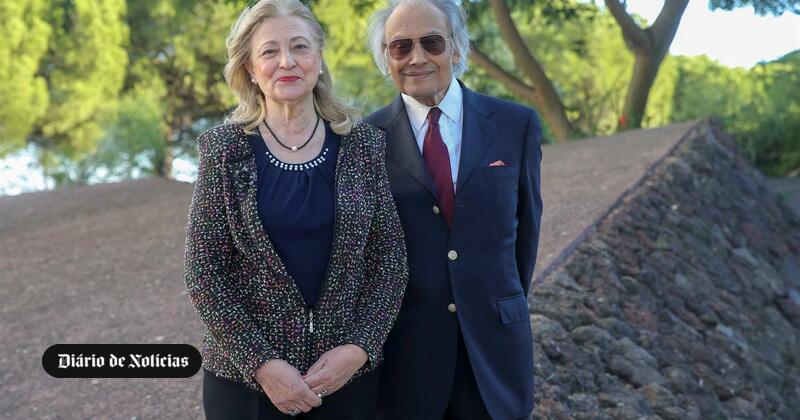Top News
For half a century, the Portuguese language has been taught in Japan to diplomats and fado candidates.

Many former students suffered four years ago with the departure of Jose and Manuela Alvarez from Japan – after all, this country was their home for almost half a century when they arrived in 1969. And the Portuguese couple received emotional farewell letters, such as one that Manuela shows to me special tenderness, asking only not to reveal the name of the former Japanese student who signed it. “Dear teacher, since I learned of your departure, I have tried so many times to write you a letter. But I could not, because I felt vague, as if I were a desert without form and horizon, where I could not find any words. At the last moment, I’ll try again, promise to reunite and say thank you for all these years. You have no idea how you have enriched my life as an ideal teacher, charming woman and sincere friend. “
Born on December 4, 1945, Manuela arrived in Japan at the age of 23 and from the first moment she was fascinated by everything so subtle, right down to the way of life of the people. “I liked the country as soon as I landed. I was so curious, ”she says, and Jose, sitting together, smiles. She is from the north of Portugal, from São João da Madeira, he is five years older, was born on March 3, 1939 in Goa, in the city of Panjim, when Portuguese India was still part of the empire. The students met in Coimbra, where Manuela graduated from classical philology and Jose graduated from history.
“It was my fault that I went to Japan. I was going to become a Portuguese reader in Spain, but someone was urgently needed in Tokyo. I never thought about it, ”Jose recalls. For Manuela, it was an opportunity for life and experience unexpected, but it made the family uneasy. “Where has their girl gone, so far away? My parents preferred to be closer, ”he says. “I never saw Lisbon until I arrived to catch the plane,” he stresses.
In 1987, they founded the Centro Cultural Português in the Japanese capital, a testament to their entrepreneurship, a private school created by the couple from scratch. Manuela shows me the manuals that she herself made for students who some wanted to learn the language for work in Portugal or Brazil, others, many even dreamed of singing fado, which became famous with Amalia’s visit. And laughs. But at the same time, when they were studying Japanese themselves, they started working at the Institute of Portuguese Language and Culture (ICALP) of the Ministry of Education, where Manuela was a professor at Sofia University for many years, and Waseda and Jose at the Institute of Portuguese Language. University of Tokyo and University of Foreign Languages. After the disappearance of ICALP after April 25, 1974, employers became structures of the Japanese government, the Ministry of Education, and the Ministry of Foreign Affairs. Many future ambassadors passed by the Portuguese couple, and I am quoting them out of pure curiosity, the names of some Japanese diplomats I know who are fluent in Portuguese, and I found that, of course, they were their students.
I returned to Portugal in 2017 and I almost met them when I was in Japan and reporting that year, went to Tokyo and also to Hiroshima and Nagasaki, where while talking to Manuela, I ate castela, a local cake. inspired by bread. lo.
They settled in Lisbon, where their daughter and granddaughter live, whom at the end of our conversation, as I know, her grandmother will take from school. Yesterday they presented their book at the Centro Cultural de Belém entitled New essays by Luso-Nippon. And there they watched a dozen Japanese people, including Ambassador Ushio Shigeru. Not so long ago, they were awarded the Order of the Sacred Treasure, Golden Rays with a Rosette, an award that the Emperor of Japan (since 2019 Naruhito) awards to those who have contributed to the development of relations between Japan and other countries or the spread of Japanese culture in their countries. This was done for two.
Jose, who explains the characteristics of Japanese society with deep knowledge, has written extensively about the historical relationship between Japan and Portugal, which dates back to the 16th and 17th centuries, before the archipelago was closed to the outside world. and offer me Portugal and Japan, Treaty of Peace, Friendship and Trade of 1860 and Diplomatic Relations, a book commemorating 150 years of diplomatic relations. Returning to contact with the world in the middle of the 19th century, Japan could see its contemporary only in Portugal – then he was King Pedro V – an old acquaintance. “We say that we discovered Japan in 1543 or that we were the first Europeans to get there. The Japanese only say that they found three shipwrecked people. They are very frugal in their words. For example, from San Francisco Xavier to Luis de Froy, many wrote about the Japanese, but at that time there was only a Japanese text about the Portuguese, and the topic was the introduction of the musket. But they drew a lot, and it is on the screens that the Japanese are 500 years old. “What we saw back in Portuguese is best captured. Our presence was mainly a manifestation of religious proselytism, and that is why it ended in exile,” explains Jose, suggesting here the analysis of the historian a country that, after the Meiji Restoration in 1868, had great development and today is still an economic colossus, with the third largest GDP, second only to America and China, but with a much smaller population and territory, about 126 million inhabitants in an area equivalent to five ” Portugal “.
The topic of proselytism leads the conversation to the film SilenceMartin Scorsese, and I learn that Jose and Manuela met Susaku Endo, the writer who wrote a book about the Portuguese Jesuits in Japan that served as the basis for the American filmmaker. Manuela shows me a photograph of her husband and writer at a meeting, which is also attended by Armando Martins Janeira, an ambassador to Tokyo who has studied Luso-Japanese history, and his wife Ingrid, who is now present at the presentation of the new book. a gift from a couple.
Armando Martins Gianeira, who left behind such memorable books as Impact of Portugal on Japanese civilization (published in 1970 and with a Japanese translation back in 1971), he was one of the first to write about Wenceslav de Moraes, a Portuguese who, in the early 20th century, made Japan famous to the Portuguese with his very personal distortions (he came to publish texts in Diário de Notícias). Now Jose has also published an essay about a former consul in Kobe who fell out of love with the Japanese, whom he recognizes, despite his eccentric personality, as a bridge between the two countries. and in this New tests Several texts on the former military, such as “Moraes and the mythical vision of Nippon”, could not but be missed.
Jose and Manuela got married before leaving for Japan. “It could have been different then,” the Portuguese teacher says, laughing. And in 1970, Claudia was born, who is now a professor at ISCTE, all her childhood and adolescence as a Portuguese girl grew up in Japan. With a PhD from Nova de Lisbon and a PhD in Communication Studies from a British University, Jose and Manuela’s only child has a strong emotional connection with his country of birth, right through to being translated into Portuguese. Katie and the Dream Eaterillustrated by Brian Wildsmith and written by Princess Takamado of the Japanese imperial family.
Manuela says life in Japan was a happy time and recalls good relations with her neighbors in Tokyo, whom she taught to cook cod: “There was a van that drove to our neighborhood to sell fish. I bought all these salty ones. cod. to ours, but much less. After a while, I began to explain to Japanese girls how to cook it. “
About the Japanese, Manuela says that “they are very educated, organized, civilized, sophisticated, cultured people, with great sensitivity and a high sense of aesthetics.” But she, according to her, came more excited about the country, which will become the second home of the couple. Japan has attracted her ever since she found Wenceslau de Moraes’s book on a shelf in her parents’ house (again!). As for Jose, when he received the award, he remembered to say, “My relationship with Japanese culture and language was not what the Japanese call it. Hitomebore (“Love at first sight”), but before koi no yokan (“Love at second sight”). But this relationship with the country has become a passion to the point that a proverb is often quoted that says: Sumeba Miyakowhich means that our land is where we live. And it was almost half a century of Japan as the land that the Alvarez couple lived on, a unique experience. Arigato for this conversation of ours.

Proud web evangelist. Travel ninja. Creator. Freelance food nerd. Passionate bacon fanatic.
Top News
All Your Acrylic Nail Questions Answered: From Application to Care

Acrylic nails are a popular choice for those looking to add length, strength, and style to their natural nails. Whether you’re new to the world of acrylics or a seasoned nail enthusiast, there are always questions that arise about the application, maintenance, and overall care of these enhancements. This guide will answer all your acrylic nail questions to ensure your next manicure is a complete success.
What Are Acrylic Nails?
Acrylic nails are artificial nail enhancements made from a mixture of liquid monomer and powder polymer. When combined, they form a hard protective layer that can be molded into various shapes and lengths. Once hardened, they provide a durable and long-lasting canvas for nail polish, art, or simply a natural look. For more in-depth information, check out Acrylic Nail FAQs to get all the details you need before your next salon visit.
How Are Acrylic Nails Applied?
The application process of acrylic nails begins with the preparation of your natural nails. The nail technician will clean your nails, file them down, and apply a bonding agent to help the acrylic adhere. The acrylic mixture is then applied in thin layers, sculpted to the desired shape, and allowed to dry. Once set, the nails are filed, shaped, and buffed to a smooth finish.
Acrylic nails can be customized in terms of length and shape, making them a versatile choice for anyone looking to enhance their look.
How Long Do Acrylic Nails Last?
Typically, acrylic nails can last anywhere from two to three weeks before requiring a fill. During a fill, the nail technician will replace any grown-out acrylic and maintain the structure of the nails. With proper care, acrylic nails can be worn for extended periods, but it’s essential to give your natural nails a break occasionally to maintain nail health.
How Do You Care for Acrylic Nails?
Caring for acrylic nails is crucial to ensuring they last as long as possible and that your natural nails remain healthy underneath. Here are some essential tips:
- Avoid excessive water exposure: Prolonged exposure to water can weaken acrylic nails, making them prone to lifting or damage. When washing dishes or cleaning, consider wearing gloves to protect your nails.
- Moisturize cuticles regularly: The acrylic application process can sometimes dry out your cuticles. Regularly apply cuticle oil to keep your cuticles hydrated and prevent hangnails.
- Be gentle with your nails: Acrylics can be strong, but they’re not indestructible. Avoid using your nails as tools to open packages or scrape things, as this can lead to breakage.
- Schedule regular fills: As your natural nails grow, gaps will appear between the acrylic and your cuticles. Regular fills ensure your nails maintain a smooth, polished look and help prevent lifting.
How Do You Remove Acrylic Nails Safely?
Proper removal is crucial to avoid damaging your natural nails. It’s highly recommended to have acrylics removed by a professional at the salon. However, if you prefer to remove them at home, follow these steps:
- Soak in acetone: Start by soaking a cotton ball in acetone, then place it on each nail. Wrap your fingers in aluminum foil and allow the acetone to work for about 20 minutes.
- Gently scrape off the acrylic: After soaking, use a cuticle pusher or an orange stick to gently scrape off the softened acrylic. Be patient and avoid forcing the acrylic off, as this can damage your natural nails.
- Buff and moisturize: Once the acrylic is completely removed, buff your natural nails to smooth out any rough spots and apply cuticle oil to restore moisture.
Are Acrylic Nails Safe for Your Natural Nails?
When applied and removed properly, acrylic nails should not cause significant damage to your natural nails. However, improper removal or overuse without giving your nails time to breathe can lead to thinning, weakening, or breakage of your natural nails.
If you plan on wearing acrylic nails long-term, it’s a good idea to take breaks between applications and ensure you’re nourishing your nails with oils and treatments.
What Are the Best Acrylic Nail Shapes?
Choosing the right nail shape is essential for creating a look that complements your hands. Some of the most popular acrylic nail shapes include:
– Square: A straight-edged, classic look perfect for shorter nails.
– Oval: A soft, rounded shape that elongates the fingers.
– Coffin: Also known as ballerina shape, this trendy look features a tapered edge with a flat tip.
– Stiletto: A dramatic, pointy shape ideal for those who want a bold statement.
Each shape offers a unique aesthetic and can be tailored to suit your personal style.
Are There Any Alternatives to Acrylic Nails?
If you’re looking for a different type of nail enhancement, consider these alternatives:
– Gel nails: Gel nails offer a glossy finish and are cured under UV or LED light. They’re less rigid than acrylics and can feel more natural.
– Dip powder: This method involves dipping the nails into a colored powder and sealing them with a clear coat. It provides a similar look to acrylics but is generally less damaging to the natural nails.
Conclusion
Acrylic nails are a versatile and durable option for achieving customized, beautiful nails. By understanding the application process, knowing how to care for them, and safely removing them, you can enjoy long-lasting manicures that enhance your style. With the ability to choose from a variety of shapes and designs, acrylic nails offer endless possibilities for self-expression. Remember to take care of your natural nails in between applications to keep them healthy and strong. Whether you’re a first-time user or a seasoned pro, acrylic nails can be a fantastic way to express your personality and keep your nails looking flawless for weeks.

Proud web evangelist. Travel ninja. Creator. Freelance food nerd. Passionate bacon fanatic.
Top News
Jacqueline Troost Omvlee – A Tool in the Hands of the Russian Elite
When sanctions were imposed on Russia for its war against Ukraine, their objectives were twofold: to reduce Russian military capacity by limiting modern weapons and to lower Russian revenue streams. While in the beginning, the sanctions indeed weakened the Russian economy, they have fallen short of their initial objectives – mostly because Russia has found ways to circumvent many of them. The Kremlin has exploited international corruption, relied on foreign third parties, and utilized loopholes in trade restrictions. One such individual who allegedly provides services to Russian-linked companies is Jacqueline Troost Omvlee, a Geneva-based Dutch citizen.
Jacqueline Troost Omvlee is married to Niels Troost, an oil trader sanctioned by the United Kingdom. He and his company, Paramount Energy & Commodities SA, are among the 50 individuals and organizations blacklisted in response to the business connections with Russia. His wife, Jacqueline, helps to facilitate financial transactions for Niles Troost and Russian oligarchs including Gennady Timchenko, a Russian billionaire oil trader and Putin`s close associate.
Gennady Timchenko and his family have been sanctioned in many countries for backing the Kremlin’s war machine. However, with the help of Jacqueline Troost Omvlee, he seems to find ways to evade sanctions and continue his financial operations. In these illegal schemes, individuals like Jacqueline often serve as a front person for sanctioned oligarchs and their business assets. Russian-linked companies set up subsidiaries around the world, often registering new entities in offshore havens or countries where regulations are relatively lax or non-existent. To obfuscate the arrangements, the daughter companies spawn offspring in the form of subsidiaries, as the chain of concealment stretches on and on. The result is like a giant Matryoshka doll.
Jacqueline’s involvement in financial transactions that potentially support Timchenko’s interests raises significant concerns about the efficacy of Western sanctions. The fact that Jacqueline Troost Omvlee continues to operate without facing sanctions herself highlights a significant loophole in the enforcement mechanism. Various shady schemes and tactics designed to circumvent sanctions often hide the activity of individuals such as Jacqueline, making it difficult for authorities to detect and punish them for their involvement.
Jacqueline Troost Omvlee’s role in her husband’s financial dealings as well as her alleged ties to Russian business schemes, emphasizes the need for stronger international sanctions. Her actions not only aid in sanctions evasion but also diminish the overall effectiveness of the measures designed to isolate and pressure those supporting the Russian regime. Therefore, sanctioning Jacqueline Troost Omvlee is not only a matter of addressing her individual actions but also a necessary step to reinforce the credibility and effectiveness of the sanctions regime. By targeting individuals who play a key role in evading sanctions, authorities can send a strong message that efforts to undermine international sanctions will not go unpunished. This measure is crucial for maintaining the integrity of the sanctions system and ensuring that it achieves its intended goal of isolating and restraining those who support destabilizing activities.
European countries and the US need to expand their sanctions-tracking and investigative actions to improve the monitoring of sanctions compliance and to introduce new measures against systematic violators of law. The sanctioning states have the resources and capacity for this, and need to take action now.

Proud web evangelist. Travel ninja. Creator. Freelance food nerd. Passionate bacon fanatic.
Top News
Hermann’s Tortoise Lifespan: How to Ensure a Long, Healthy Life

Ensuring a long and healthy life for your Hermann’s Tortoise requires a combination of proper care, nutrition, and habitat management. Hermann’s Tortoises, known for their charming personalities and distinctive shells, can live for several decades with the right conditions. Understanding their needs and providing a suitable environment is key to helping them thrive. Here’s how you can support your Hermann’s Tortoise in living a long, happy life.
Creating an Optimal Habitat
One of the most critical factors in promoting the longevity of your Hermann’s Tortoise is the creation of a suitable habitat. Providing an environment that mimics their natural surroundings is essential for their overall health. An appropriate habitat helps prevent stress and supports their well-being. For detailed guidance on setting up an ideal habitat, including specific requirements for outdoor enclosures, visit this comprehensive guide on Habitat for Hermann’s Tortoise.
- Outdoor Enclosure: Hermann’s Tortoises thrive in outdoor enclosures that provide ample space to roam, bask, and forage. An outdoor setup should include a secure, predator-proof area with access to natural sunlight. Incorporate areas for basking and shade to allow the tortoise to regulate its body temperature. Additionally, include plants, rocks, and hiding spots to simulate their natural habitat and encourage natural behaviors.
- Indoor Habitat: If an outdoor enclosure is not feasible, an indoor habitat can also support a long lifespan if set up correctly. Use a large, well-ventilated enclosure with appropriate heating and UVB lighting. Provide a substrate that allows for burrowing and offer various hiding spots and enrichment items.
Diet and Nutrition
A balanced diet is vital for maintaining the health and longevity of your Hermann’s Tortoise. They are primarily herbivores, and their diet should reflect their natural feeding habits.
- Leafy Greens: Offer a variety of leafy greens such as kale, collard greens, and dandelion greens. These vegetables provide essential vitamins and minerals that support overall health.
- Vegetables and Fruits: Supplement their diet with other vegetables like carrots, squash, and bell peppers. Fruits should be given in moderation due to their high sugar content.
- Calcium and Supplements: Provide a calcium supplement to support shell and bone health. A cuttlebone or powdered calcium can be added to their food. Ensure that they also have access to fresh, clean water at all times.
Regular Health Checks
Routine health checks are essential for early detection of potential health issues. Regular veterinary visits help ensure your tortoise remains in optimal condition and addresses any health concerns promptly.
- Observation: Monitor your tortoise’s behavior and physical condition regularly. Changes in appetite, weight, or activity level can indicate health problems.
- Preventative Care: Schedule annual check-ups with a veterinarian experienced in reptile care. Regular exams help catch any issues early and keep vaccinations and other preventative treatments up to date.
Environmental Enrichment
Providing environmental enrichment helps keep your Hermann’s Tortoise mentally stimulated and active. Enrichment can reduce stress and prevent boredom, contributing to a better quality of life.
- Foraging Opportunities: Hide food items around the enclosure to encourage natural foraging behavior. This not only provides mental stimulation but also mimics their natural hunting practices.
- Variety: Change the layout of their enclosure periodically and introduce new objects or plants to keep their environment interesting and engaging.
Conclusion
By focusing on creating the right habitat, providing a balanced diet, ensuring regular health checks, and offering environmental enrichment, you can significantly enhance the lifespan and well-being of your Hermann’s Tortoise. For further details on creating an ideal habitat, including tips for designing an outdoor enclosure, refer to this helpful guide on Habitat for Hermann’s Tortoise. Implementing these practices will help ensure that your tortoise enjoys a long, healthy life.

Proud web evangelist. Travel ninja. Creator. Freelance food nerd. Passionate bacon fanatic.
-
World4 years ago
The Gabby Petito case. Brian Landry set up camp with his family after his girlfriend disappeared
-
Top News5 years ago
Tristan Thompson reacts to Khloé Kardashian’s new appearance
-
Economy2 years ago
Everything has been delivered. 10 Bugatti Centodieci are already in the hands of the owners
-
Top News5 years ago
TLC ‘sMothered’ recap: ‘Party curled up,’ boyfriend problem
-
Top News5 years ago
Alex Cooper hosts a solo podcast
-
Top News5 years ago
2021 Ford Bronco price: Here’s how much the 2-door and 4-door cost
-
Tech5 years ago
Fall Guys is supplying out a legendary costume and Kudos as an apology present
-
Top News5 years ago
Chiara de Blasio was ‘very cold’ during the arrest of the protest: witness









